INTRODUCTION
Weed control is one of the main technical difficulties in no-till, organic maize production, which, according to Brazilian law, excludes the use of herbicides (MAPA, 2011).
Weeds adversely interfere with crops because of their direct competition for water, sunlight, nutrients and space. In addition, some species produce allelochemicals that are detrimental to the development of other plants (Concenço et al., 2014). A 56.55% decrease in maize yield occurred when weeds were controlled 28 days after emergence (DAE), reducing kernel yield from 10,605.8 to 4,608.15 kg ha-1 (Balbinot et al., 2016).
In the organic system, the predominant weed management wass hand hoeing or ripping out in the tillage system (Spagnolo et al., 2017) and mowing in the no-till system (Gomes and Christoffoleti, 2008). These management systems can make organic production unfeasible on medium- or large-size properties because they increase production costs and are not always effective. Vaz de Melo et al. (2007) found a higher total weed biomass production in the organic system when compared to the no-till system with use of herbicides, especially because of the high re-sprouting ability of some weed species. Proposals to improve efficiency of weed management in no-till organic maize cultivation include increasing the speed of maize crop establishment and reducing weed infestation. In this regard, it is vital to integrate cultural and mechanical methods of control (Oliveira and Brighenti, 2018).
With respect to the cultural methods, reducing spacing between rows in maize crops from 0.90 to 0.45 m can ensure higher yields at densities of 60,000, 75,000 and 90,000 plants/ha (Stacciarini et al., 2015) and suppress weed biomass accumulation (Nunes et al., 2010). Takuso et al. (2014) observed that, with 0.45 m spacing between rows, there was an increase in plant height, ear insertion height, number of kernels per row and kernels per ear, 100-grain weight and yield. Reduced spacings favored increased sunlight interception by the canopy of cultivated plants; therefore, the crop occupied space more rapidly, reducing the availability of resources for weed growth and development (Knezevic et al., 2003).
An alternative is to grow maize intercropped with green manuring species. Similar to what occurs with reduced spacing, an intercropped species occupies space and competes for resources with weeds, reducing infestation (Oliveira and Brighenti, 2018). Correa et al. (2014) evaluated the effect of intercropping maize and jack bean (Canavalia ensiformis DC.) on weed dynamics during four consecutive growing seasons of maize under the organic, no-till system and found a reduction in the relative importance of Artemisia verlotorum Lamotte, Bidens pilosa L. and Digitaria sp. species, which are often found with greater infestation in the organic, no-till system because they are not efficiently controlled with mowing (Vaz de Melo et al., 2007).
Thus, this study aimed to assess the effects of associating mechanical control methods (mowing and hoeing) with cultural methods (spacing reduction and intercropping with jack bean) on the phytosociology, weed dry matter accumulation and maize kernels yield under the organic, no-till system.
MATERIAL AND METHODS
This experiment was carried out during the 2009/10 growing season in an experimental area located at the Federal University of São Carlos - UFSCar, campus of the municipality of Araras, SP (Brazil), latitude 22°30'78" S and longitude 47°38'59" W 646 m altitude. According to Kõppen, the weather in the region is Cwa, humid tropical, characterized by hot, humid summers and dry winters. The meteorological data during the experiment were obtained from the Automatic Weather Station (AWS) at UFSCar, Araras, SP, Brazil (Fig. 1).
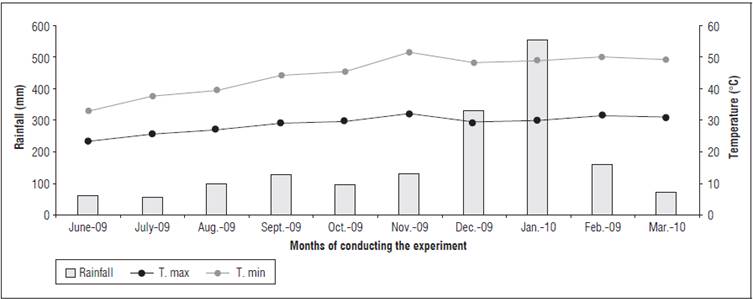
Figure 1 Representation of rainfall, minimum average temperature, and maximum average temperature for the experiment period. Araras, São Paulo, Brazil, 2009/10.
The soil was classified as clayed dystrophic Red Latosol (NVdf) (Embrapa, 2013). The soil chemical characteristics were determined with a soil analysis before the lime application (Tab. 1).
Table 1 Results of soil chemical and physical analysis of the experiment area at a depth of 0 to 20 cm. Araras, São Paulo, Brazil, 2009/10.

The experiment design consisted of randomized blocks with four replicates and a 2x3x2 factorial arrangement. The first factor consisted of the presence or absence of jack bean (C. ensiformis) in the maize rows; the second factor corresponded to two different spacings between the maize rows (0.4 and 0.8 m), and the third factor consisted of three weed control methods (hoeing, mowing, and no weed control). The size of the experimental plot was 20 m2 (5x4 m), and the usable area (net area used for assessments) was 8 m2 (4x2 m).
In June, 2009, lime was applied to the soil to raise the base saturation to 70%, and 30 d after liming, broadcast sowing of black oat (Avena strigosa Schreb.) was carried out at a density of 80 kg ha-1 of seeds. In late October, 2009, black oat plants were cut using a backpack brush cutter, and the straw was left on the ground for approximately 5 d for natural desiccation. Then, direct sowing was done using a hand seeder, and maize variety AL 25 was sown in the rows, spaced at 0.4 and 0.8 m apart, according to treatment, for a population of 55,000 plants/ha in both treatments. In the plots with jack bean, eight Fabaceae seeds per meter were sown, concomitantly with maize, using a hand seeder. After emergence of the jack bean plants, they were thinned, keeping six plants/m.
The planting fertilization was defined for an expected maize grain yield of 6.0 to 8.0 t ha-1 (Coelho, 2006). A commercial organic fertilizer (Ciafertil®) was used at a rate of 14.12 t ha-1 (dry compost weight), approximately 40 m3 ha-1, to provide the nitrogen required by the maize, i.e., 120 kg ha-1 (Raij et al., 1996). Accordingly, 68 and 41 kg ha-1 of P2O5 and K2O, respectively, were applied according to the chemical characteristics of the compost: 0.85% N, 0.48% P2O5, 0.29% K2O, 3.6% CaO, 0.29% MgO and 0.48% SO4 on dry basis.
Weed control in the plots using a hoe was done whenever needed to allow the maize plants to grow freely in total absence of infesting species. In the plots using a mower, the weeds were cut close to the ground using a backpack mower at two different times: at stages V4 and V8, when the maize leaves were fully developed.
The weed species, except for the treatment using hoe, were assessed at two different times: when the maize plants were at stage V4, prior to the first weed cutting, and the second assessment when the maize plants were at stage V8, prior the second cutting.
Weeds were collected by throwing a 0.25 m quadrat frame randomly in three samplings per plot. Weed specimens were cut close to the ground, separated per species and dried in a forced-air oven for 72 h at 70°C for determination of dry matter per species and total dry matter per plot. Subsequently, a descriptive analysis was conducted using phytosociological parameters represented by relative frequency (RF), relative density (RD), relative dominance (RDo) and relative importance (RI) of the species present in the weed community at each treatment (Concenço et al., 2013).
The grain yield was determined after manual harvesting of ears from each usable plot area, which were then threshed, and the kernels were weighed by correcting the weight to 13% moisture. The jack bean dry matter was determined before harvesting the maize ears by collecting the plants present in 1 m of the planting row, which were dried in an air-circulation oven at a temperature of 65°C to constant weight. The values were described as ton ha-1.
The data relating to maize grain yield and jack bean dry matter were subjected to analysis of variance with the F-test, and the mean values of the treatments were compared with the Tukey test (P≤0.05) (Pimentel-Gomes and Garcia, 2002). The phytosociological data were analyzed with descriptive statistics.
RESULTS AND DISCUSSION
In the first phytosociology assessment, at stage V4 of the maize plants, prior to weed cutting, 21 weed species were found in the experiment area: Cyperus rotundus L., B. subalternans DC., P. maximum (Jacq.) B.K. Simon & S.WL. Jacobs., Acanthospermum hispidum DC., Amaranthus viridis L., Raphanus raphanistrum L., Stachys arvensis L., Sonchus oleraceus L., Galinsoga parviflora Cav., G. quadriradiata Ruiz & Pav., Ricinus communis L., Parthenium hysterophorus L., Chamaesyce hirta Millsp., Ageratum conyzoides L., Commelina benghalensis L., Ipomoea purpurea (L.) Roth., Euphorbia heterophylla L., Leonotis nepetifolia (L.) R. Br., Oxalis latifolia Kunth., Phyllanthus tenellus Roxb. and Eclipta prostrata (L.) L. The species C. rotundus exhibited the highest percent values of RF, RD, RDo and RI, irrespective of the management systems (Fig. 2).
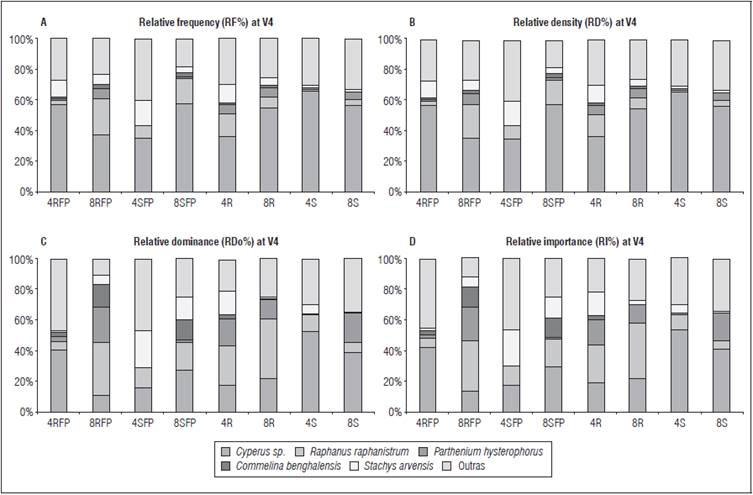
Figure 2 Effects of weed management systems (R: mowing; S: without control), maize crop spacing (4: 0.4 m; 8: 0.8 m) and presence (FP) and absence of C. ensiformis on weed frequency (A), density (B), dominance (C) and relative importance (D) in the maize crop, evaluated in the fourth fully developed maize leaf. Araras, São Paulo, Brazil, 2009/10.
The species C. rotundus is commonly found in soil-revolving agricultural systems because the farming implements used to move soil favor the division of tubers and break apical dominance of this plant (Jakelaitis et al., 2003). The experiment area was at the second year after implementation of the no-till system, which can explain the predominance of this species in the area. The plots with exclusive maize cultivation at a spacing of 0.8 m had a greater number of species than the maize intercropped with jack bean with the same spacing arrangement (Fig. 2).
In the second phytosociology assessment, stage V8, before the second mowing, 16 weed species were found in the experiment area: P. maximum, S. arvensis, G. parviflora, G. quadriradiata, P. tenellus, A. verlotorum, A. hispidum, C. benghalensis, A. deflexus L., C. iria L., Leonurus sibiricus L., L. nepetifolia, A. viridis, I. purpurea, A. conyzoides and R. raphanistrum (Fig. 3).
There was a decrease in species richness, down from 21 species in the first assessment to 16 species in the second assessment. The species B. pilosa, S. oleraceus, C. hirta and O. latifolia, identified in the first assessment, on the 60th day, after mowing, were not found. In turn, the species began to be part of the weed community in the experiment area.
The species A. deflexus and L. sibiricus were identified in the plots grown with maize intercropped with jack bean, without weed control, irrespective of spacing. The microclimate, shade and moisture provided in this system, along with the greater competition promoted by jack bean, may have contributed to the establishment of some species to the detriment of others.
The species P. maximum exhibited the highest RD, RDo and RI, irrespective of the management systems (Fig. 3), different from the values observed in the first assessment, in which the species with the highest RDo was C. rotundus. This fact corroborated the premise of a change in the infesting weed population in the area as a result of the greater competition and shading in the maize rows. In this case, the species P. maximum may have been favored because, according to Andrade et al. (2004), it has a high production capacity, even under 70% shade.
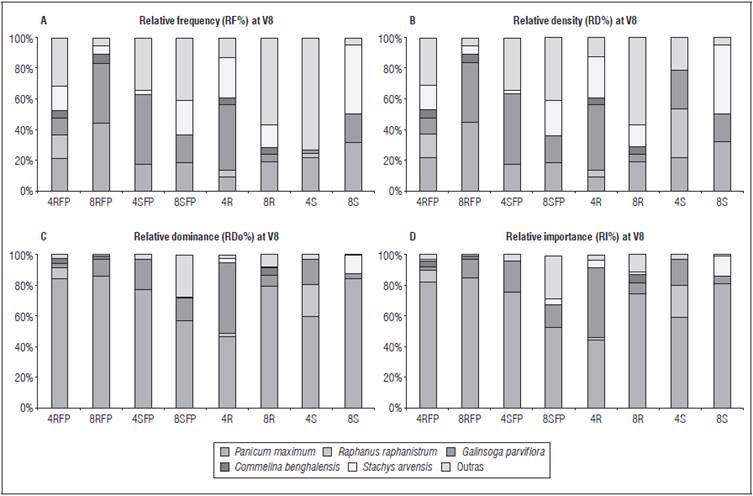
Figure 2 Effects of weed management systems (R: mowing; S: without control), maize crop spacing (4: 0.4 m; 8: 0.8 m) and presence (FP) and absence of C. ensiformis on weed frequency (A), density (B), dominance (C) and relative importance (D) in the maize crop, evaluated in the fourth fully developed maize leaf. Araras, São Paulo, Brazil, 2009/10.
The species P. maximum exhibited an equivalent RI% in the 0.4 and 0.8 m spacings in the maize rows, both in the treatment without control and in the treatment with mowing (Fig. 3). This result suggests that reduced spacing and mowing were not effective in reducing growth and establishment of this weed species.
Mowing removes shoots, which consequently causes plant stress. The percentage of leaf and stem losses represents a reduction of sunlight interception as well as lower rates of canopy net photosynthesis and a decrease in roots activity (Davidson and Milthorpe, 1966). However, when a species exhibits stem reserves and easy dissemination, mechanical control (mowing) is not quite efficient.
Effective weed control with mowing depends on the species present in the infesting community. For B. pilosa, this method proved to be viable when performed 14 and 25 d after maize emergence because it managed to inhibit seed production. But for C. benghalensis, this method was not effective, considering the high rate of leaf area, irrespective of when mowing was conducted (Lemos et al., 2013). However, Chiovato et al. (2007) observed that two cuttings conducted at stages V4 and V8 resulted in a lower accumulation of leaf and stem dry matter in maize plants when subjected to interference by B. pilosa.
A reduced RI% with P. maximum was also not observed in the treatment of maize intercropped with jack bean at a spacing of 0.4 m (Fig. 3). But in the 0.8 m spacing between rows with maize-intercropped with jack bean, the treatment without control reduced the RI% of P. maximum, probably because of the higher competition with jack bean plants and other weed species.
The 0.8 m spacing with jack bean was more effective in restricting the RDo and RI of P. maximum. In this treatment, jack bean achieved the highest dry matter accumulation (4 t ha-1, see later), that is, the Fabaceae plants established quickly because of the greater penetration of sunlight, occupying the space before the weed species.
Oliveira et al. (2014) observed 10 weed species in a maize monoculture, especially Rottboelia cochinchinensis (Lour.) Clayton, Sorghum arundinaceum (Desv.) Stapf. and Alternanthera tenella Colla., but, in maize intercropped with C. ensiformis, Crotalaria juncea L. or Mucuna aterrima (Piper & Tracy) Holland., eight species were found, resulting in a lower accumulation of weed dry matter, especially for monocotyledons.
The 0.4 m spacing between rows favored the dominance and RI of species S. arvensis, Acanthospermum sp., A. viridis and C. benghalensis (Fig. 3). The favoring of these weed plants over other species may have been due to the larger shading area. In these treatments, there was also a reduction of RI for P. maximum, which may have contributed to the establishment of other species as a result of the lack of competition.
The analysis of variance for the grain yield variable revealed a significant effect from the following interactions: weed plant management x spacing between maize rows and management of weeds x presence and absence of jack bean (Tab. 2).
Table 2 Maize grain yield as a function of weed management and line spacing. Araras, São Paulo, Brazil, 2009/10.
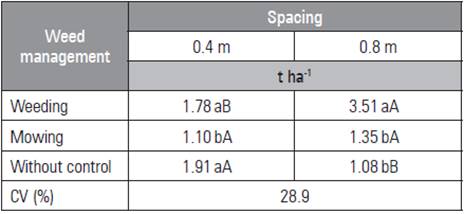
Means with different letters, lowercase in the columns and uppercase in the rows, indicate a significant statistical differences according to Tukey test (P≤0.05) (n=4).
Mowing for both maize spacing arrangements (0.4 and 0.8 m) reduced the kernel yield (Tab. 2), probably because the weed plants were not efficiently controlled. Reduced spacing hindered mowing, which was done until maize stage V4; after this stage, mowing cut the maize plants.
The grain yields may have been affected by the spacing between rows and seed density. The variety AL 25 is recommended for seeding between 0.8 and 1.0 m, which may have contributed to a reduced yield, even maintaining adequate plant density.
The 0.8 m spacing, associated with hoeing, was the treatment that achieved the highest grain yields (Tab. 2). In the maize-jack bean intercropping, irrespective of the spacing between rows, hoeing provided the highest grain yield, without differences from the treatment without jack bean (Tab. 3).
Table 3 Production of maize grains according to weed management and presence and absence of Canavalia ensiformis. Araras, São Paulo, 2009/2010.
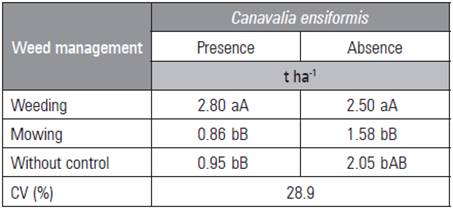
Means with different letters, lowercase in the columns and uppercase in the rows, indicate a significant statistical differences according to Tukey test (P≤0.05) (n=4).
The maize grain yield was similar to the one observed by Pereira et al. (2011) in a monoculture, in maize intercropped with C. juncea (cut at the 8th expanded maize leaf) and in maize with C. juncea without cutting. Jack bean, at a density of 31,250 plants/ha, did not affect ear length, ear diameter, number of kernel rows per ear, 1,000-seed weight or kernel yield (Saldanha et al., 2017).
The presence of jack bean provided the same maize kernel yield with mowing and without weed control (Tab. 3). In these treatments, the same production rates of jack bean dry matter were obtained, lower than the dry matter production for the treatment with hoeing (Tab. 4). This suggests that the weeds with mowing and without control competed with both maize plants and jack bean plants, reducing their development and dry matter production.
Table 4 Yield of dry matter of Canavalia ensiformis at the end of the maize cycle, as a function of weed management. Araras, São Paulo, Brazil, 2009/10.
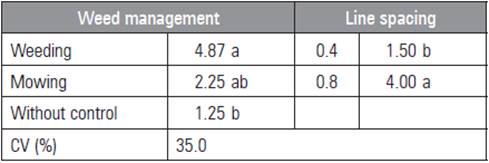
Means with different letters indicate a significant statistical differences according to Tukey test (P≤0.05) (n=4).
The jack bean dry matter production was lower in the 0.4 m spacing (Tab. 4). Collier et al. (2011) also found a reduced dry matter for jack bean intercropped with maize grown with 0.45 m spacing.
Therefore, more studies are necessary to understand the dynamics of the weed community and the alteration of infesting plants in the transition to and establishment of organic, no-till planting. The chosen management method must always favor maize plants to the detriment of weeds, but, to accomplish this, it is necessary to know which control methods can be adopted without favoring certain species.
CONCLUSIONS
The weed community changed during the maize growing cycle as a result of alterations provided by the growth and establishment of maize and jack bean plants, changing the competition patterns.
Jack bean intercropped with maize with spacing at 0.8 m between rows can be a good alternative for producing maize in organic, no-till cultivation but requires at least one hoeing when the fourth leaf of the maize plants is developed.















